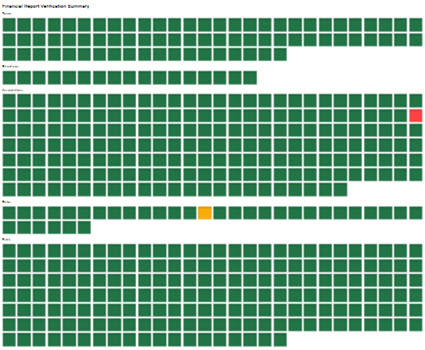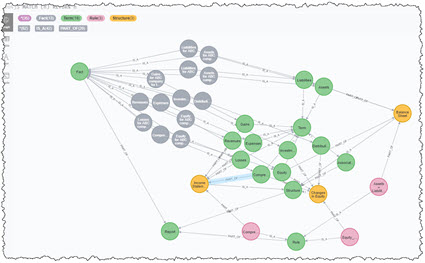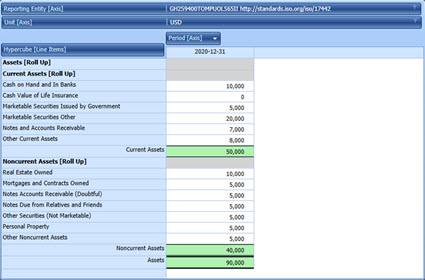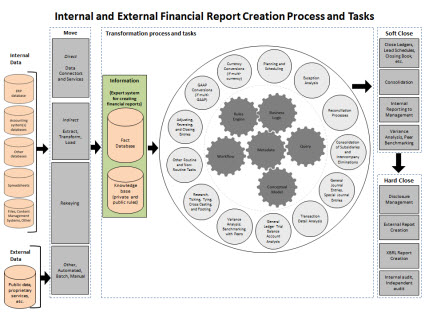BLOG: Digital Financial Reporting
This is a blog for information relating to digital financial reporting. This blog is basically my "lab notebook" for experimenting and learning about XBRL-based digital financial reporting. This is my brain storming platform. This is where I think out loud (i.e. publicly) about digital financial reporting. This information is for innovators and early adopters who are ushering in a new era of accounting, reporting, auditing, and analysis in a digital environment.
Much of the information contained in this blog is synthasized, summarized, condensed, better organized and articulated in my book XBRL for Dummies and in the chapters of Intelligent XBRL-based Digital Financial Reporting. If you have any questions, feel free to contact me.
Silo Mentality
Software vendors have a "silo mentality" it seems. None of these software vendors seem to understand the power of standards:
- Uncat for categorizing uncategorized transactions in Quickbooks.
- Circit for bank confirmations
- Adapio for bank transaction analysis
- Autoreview for reviewing bookkeeping discrepancies
- Mindbridge for audit and assurance
- Engine B for audit common data model
- Quickbooks for accounting
- Logdeit for tax filing and XBRL generation
- Aoralaw for making tax decisions
I could list many others. Not one of these application shares information with other applications, i.e. each essentially works in an individual silo (other than some interact with Quickbooks).
Great perspective for each individual software application trying to lock in their customers; incredibly dumb perspective from the point-of-view of a business (i.e. customer) that needs to use those software applications and the functionality provided by each.
This silo mentality or application centric view of the world is outdated and it will not work for modern approaches to accounting.
Standards make markets. These people might want to read and understand "The Box" which explains how the ISO standard shipping container made the world smaller and the world economy bigger.
Universal Personal Financial Statement
Today, there are a multitude of personal financial statement formats. For example, here are a handful of different personal financial statements:
- General Purpose Personal Financial Statement (From TemplateLab)
- U.S. Small Business Administration Personal Financial Statement
- U.S. Bank Private Banking Personal Financial Statement
- Universal Surety of America Personal Financial Statement
- TemplateLab 40+ Personal Financial Statement Templates
- Sample.net 34+ Sample Personal Financial Statement Templates
Imagine one high quality universal personal financial statement. I talked about streamlining personal financial reporting in another blog post.
In fact, I created a personal financial statement XBRL taxonomy. I did this for two reasons. First, I think there needs to be a set of universal personal financial statements. Second, this is an excellent learning tool for professional accountants that need to understand how to create a proper XBRL taxonomy for financial reporting.
The current US GAAP and IFRS XBRL Taxonomies are more "pick lists" that are intended for humans to use. An XBRL taxonomy should be for both humans to use but also for computers to use and leverage. I am thinking of holding some classes and help professional accountants understand what makes a good XBRL taxonomy and why. If you are interested please contact me and let me know.
XBRL is a Knowledge Graph
Earlier this week I watched a video on the Auditchain web site relating to a demonstration of the DCARPE Explorer. There was an interesting graphic between 52 seconds and 1 minute 9 seconds in the video that had a grid of facts. A few days later I was talking to Jason Meyers, the CEO of Auditchain, and he brought that graphic up and explained it. That gave me an idea that explains two things.
First, I have pointed out before that an XBRL-based digital financial report is a finite, discrete set of statement. This graphic shows this visually; each GREEN square represents a discrete statement that is verified to be correct, each ORANGE square represents a discrete statement that is worth looking at in more detail, and each RED is an error: (click the image for a prototype HTML page)
Here are similar representations for the accounting equation, SFAC 6 elements of financial statements, my Proof representation, and for the 2017 Microsoft 10-K financial report. The bigger the report, the more "squares" or pieces of the report. For example, the Microsoft 10-K has:
- 899 terms
- 128 structures
- 3,296 associations
- 0 rules (i.e. XBRL Formulas, XBRL calculation associations are counted in the associations above)
- 2,235 facts
So, you have a set of discrete statements and you need to verify that each of the statements is correct. The accounting equation has fewer statements, SFAC 6 a few more, the Proof has more, and the real Microsoft 10-K has the most.
That flat list hs useful, but you cannot see the assocations between the statements. Another useful view of the information or statements made by the report is that of a knowledge graph. Here is a partial knowledge graph for SFAC 6 created using Neo4j: (click the image for a larger view)
In the knowledge graph above of SFAC 6 you can see the assications between the individual discrete pieces of information.
That same information can also be rendered in human readable form. Here is the human readable form for the accounting equation, SFAC 6, the Proof, and Microsoft 10-K. The rendering is simply a reorganizing of the same statements that you see in the flat list, the knowledge graph, or the XBRL tecnnical syntax: (click image for larger view)
XBRL is effectively a knowledge graph. You could express that same information in Cypher, Prolog, RDF+OWL+SHACL (or some other rules language), or some other problem solving logic paradigm.
Whatever syntax you prefer you still need to understand the logic and how to work with knowledge graphs effectively. If you want to learn about these important knowledge graphs, study the Microsoft 10-K.
#############################
Streamlining Personal Financial Reporting using XBRL
Personal finance is very disjointed and provides an excellent example of the power of something like XBRL to streamline processes.
First, you can think about a personal financial statement as somewhat of a "dashboard" into your personal finance. Your personal finance might include your checking accounts, savings accounts, credit cards, investments, your home, any student loans, your retirement plan, life insurance, family and estate planning, social security, and so on. People such as Suze Orman and organizations like Charles Schwab and others can help you create a financial plan. Basic accounting software like Quickbooks, Xero, and Wave among others can help you keep track of things. TurboTax and H&R Block and Taxly can help you file your tax returns.
There are different formats for personal financial statements. The U.S. Small Business Administration has their personal financial statement form. Lots of different personal financial statement templates exist. Here is one, another, and another.
All of this tends to be very disjointed, few things "talk" to each other. Why is that? A big part of this is that each software vendor or service provider wants to "own" the customer. Another reason is the application centric mentality that software vendors tend to have. What if software were more data centric?
Google might be changing all this. Apparently Google wants to be the "operating system of personal finance". Apple seems to be after this also.
What if: (a) more standards where used, (b) better coordination existed, (c) metadata and models were defined to help things along this process, (d) artificial intelligence was used to make software smarter, (e) automated quality checks were built into processes where possible.
As I pointed out in my effective automation of the record to report process prototypes, there is a lot that can be automated. If it can be, it likely will be.
If you want to get your head around the possibilities here, read Computational Professional Services.
What I am going to do is create an XBRL taxonomy for creating personal financial statements. Stay tuned! (Here is the first installment of the XBRL taxonomy for personal financial statements.)
######################################
Effective Automation of Record to Report Process (Iteration #4)
Effective Automation of Record to Report Process (Iteration #4) is my fourth iteration of a prototype of automation of the record to report process. This example is deliberately crafted to help you understand the process and see where improvements can be made. (Here are iterations 1, 2, and 3)
The significant benefit of this iteration include:
- I am using the Microsoft Dynamics accounting system database as the accounting system that is populated with The World Online (TWO) sample company data.
- Engine B Common Data Model (CDM) is used.
- Substantially improved version of my XBRL instance creator is being used.
- The documentation is substantially better.
- Everything you need to duplicate what I have created is provided.
To get a quick idea about what the prototype explains, flip through these slides.
Why is this useful information? This information is useful because it help you understand modern approaches to accounting. This can likewise work for streamlining personal finance. I essentially provide a complete implementation of accounting transactions flowing from the general ledger all the way to the financial report. Ultimately, more of these processes and tasks will be automated:
You actually don't need to use XBRL as I did. But, using XBRL rather than some proprietary approach does have it's benefits. Really any problem solving paradigm can be used.
############################
Altova End-to-End XBRL Solution
COSO Model for Internal Controls
SAP R2R Series #5: Hard Close, Soft Close, Fast Close, Continuous Accounting




